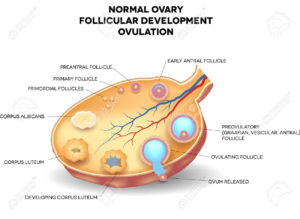We always hear about how interesting men’s sperm are – how quick, agile and strong they are, able to traverse the long journey to the egg, but how much do we know about the other genetic half of a child – the female egg?
In writing this article, I came across some really interesting information about human eggs that I think we should all know! Read on to learn some of the most fascinating facts about human eggs, and the intricate processes of ovulation and conception.
1. Women May Be Making New Eggs Throughout Their Lives
For a long time, biology books have stated that a woman is born with a finite number of eggs – that the production of a woman’s eggs happens entirely in-utero, and ceases before birth. It is usually reported that a woman has 7 million immature eggs when she is in her mother’s womb, and that this number drops to 700,000 by the time she reaches puberty.
But recent research has been turning this theory on its head. Scientists have discovered a new type of stem-cell in the human ovary that may point to the possibility of new eggs continually being formed throughout a woman’s reproductive years. Since men are constantly making new sperm (about 1,500 every second!), it shouldn’t be such a stretch to consider that women may be producing new eggs throughout their lives as well. Further research will be able to confirm this new theory, and continue expanding our view of women’s fertility.
2. A Human Egg is Remarkably Big
You might be surprised to find out that the human egg is one of the biggest cells in a woman’s body. It is about the size of a grain of sand and can actually be seen with the naked eye. To put this into perspective, an egg is about 4 times bigger than a skin cell, 26 times bigger than a red blood cell, and 16 times bigger than a sperm!
3. An Egg Takes a Long Time to Mature
Most eggs are present within the ovary in an immature state from the time of a woman’s menarche. Some eggs will lie dormant for years or even decades before they begin to mature, while others will degenerate and never develop. For eggs to complete their journey to ovulation, they receive a signal to begin their final maturation process about 150 days before they would be released from the ovary. At the beginning of any given cycle, there are generally about 12 eggs that have started to grow, and as ovulation nears, preference is given to one of those eggs, as it receives the final push to maturity and is then released from the ovary.

4. The Egg Has a Short Life After Ovulation
Once the egg has matured and is released from the ovary during ovulation, it goes into the fallopian tube where it lives for 12 to 24 hours. Conception is possible if sperm is already present in the fallopian tubes when the egg is released, or if a woman has sex while the egg is alive, causing sperm to swim up through the uterus and into the fallopian tube. Sperm can reach the egg in as little as 30 minutes. If conception is successful, the newly fertilized egg will travel out of the fallopian tube and implant into the uterus 6 to 10 days later. If the egg is not fertilized, it will simply dissolve and pass out with the menstrual flow.
Though the egg has a lifespan of less than a day, sperm can stay alive inside a woman’s uterus and fallopian tubes anywhere from 1 to 5 days. This means that sex up to 5 days prior to ovulation can actually result in pregnancy! The lifespan of the sperm is dependent on the sperm’s health, but also on the woman’s cervical fluid, which can nourish the sperm during its wait.
5. The Egg is Quite Picky
When discussing fertilization, the egg is often portrayed as a passive player in the drama of conception, waiting patiently for the first sperm to arrive and burst in. But research has shown that the egg has a much bigger role than previously thought, and that she is in fact quite picky! Although we usually think of the sperm doing all the hard work of fertilization, penetrating the docile egg, it is now believed that the egg actually chooses who she lets in or not.
The egg appears to give preference to sperm with intact DNA, producing a compound that softens the outer layer of the egg to allow specific sperm to enter. These studies also suggest that the egg may even actively bind sperm to its surface, thereby not giving the sperm any choice in the matter, trapping the sperm it has chosen. Once a sperm has made its way in, the outer layer of the egg hardens, which prevents entry to any other suitors.
6. Multiple Ovulation is More Common Than You Think
Multiple ovulation is the release of two or more mature eggs during a cycle. This is said to occur in up to 10% of all cycles, which means that the average woman releases two (or more) eggs at least once a year! When 2 eggs are released and both are fertilized, this produces fraternal twins. Identical twins are produced when a single embryo splits into two.
It is important to note that whenever double ovulation occurs, it happens as part of a single ovulatory event – the eggs will be released within a 24 hour period. Once ovulation occurs, there is a big hormonal shift that takes place, progesterone production is revved up, and the release of any future eggs is halted. Therefore, it is not possible for a woman to ovulate on Monday, and ovulate again on Saturday.
This article first appeared on Natural-Fertility-Info.com

